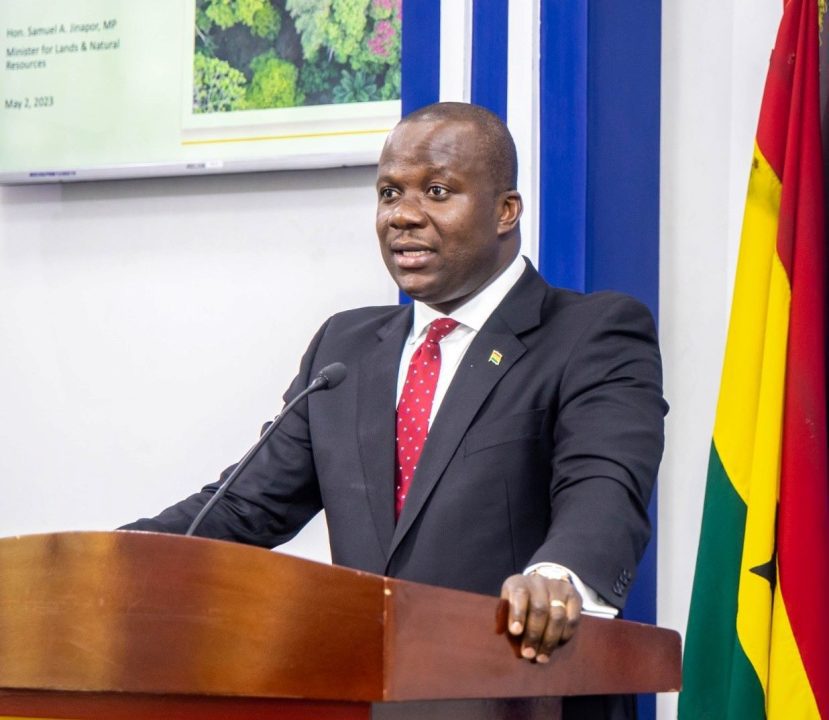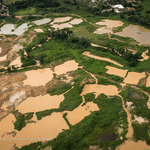A total of 547,891.70 hectares of degraded forest lands have been cultivated between 2017 and 2021.
157,300 hectares cultivated in 53 years
It represents a 348.3% increase and is far in excess of the 157,300 hectares of degraded forest lands cultivated between 1963 and 2016, a period of 53 years.
6.6m hectares of forest
Ghana has some estimated 6.6 million hectares of forest, made up of 1.2 million hectares of closed forest and 5.4 million hectares of open forest.
These have, however, come under threat, largely, from activities such as illegal mining and illegal logging.
Lands and Natural Resources Minister, Samuel Abu Jinapor, announced this at the Minister’s Media Briefing in Accra.
Galamsey ravages 34 forest reserves
Despite this laudable achievement, data from the Forestry Commission shows that illegal mining resulted into degraded forest lands in some 34 out of 288 forest reserves with significant impact.
4,726.2 hectares destroyed in forest reserves
According to the data, the total mapped area of forest reserves illegally mined amounted to 4,726.2 hectares of degraded forest lands.
Over 28,000 hectares lost each year between 2010 and 2015
Jinapor said available data also shows that, between 2010 and 2015 alone, Ghana lost, on the average, over 28,000 hectares of forest each year, peaking at 35,000 hectares in 2014, largely due to illegal mining and illegal logging.
Various attempts to fight galamsey unsuccessful
He chronicled various attempts to fight galamsey without success setting out all the facts, including the historical antecedent to be able to marshal a critical mass of support for government’s policy in this very crucial sector.
Gravity of forest loss
Jinapor who is the Member of Parliament (MP) for Damongo in the Savannah Region said, “whilst we acknowledge the gravity of forest loss and its adverse consequences on our survival, let us face facts, deforestation and forest degradation, sadly, are not new phenomena in our country”.
8.2m forest covers in 1900
For instance, in 1900, the country’s forest cover was estimated to be in excess of 8.2 million hectares, largely covering the whole of southern Ghana.
Close to a third lost
Close to a third of the 8.2 million hectares was lost by the middle of the century, mainly through agricultural expansion and infrastructural development.
60% of forest cover lost by 2,000
However, by the end of the century in 2000, Ghana had lost approximately 60% of this forest.
Money at the heart of the various illegal enterprises
“At the heart of these various illegal enterprises, is money, and, once we are dealing with money, the cartels operating in our forest reserves will find every means of outwitting our efforts.
Govt remains absolutely determined
“But, the Government of President Akufo-Addo remains absolutely determined to protect and preserve these resources for current and future generations. We will not relent!” he stressed.
Cartels in the forest reserves
Jinapor emphasised that the fight against these illegal enterprises and the cartels in the forest reserves will not be an event, but a process, noting that what is important is the commitment to protect and preserve these resources, which his Ministry is fully determined to do.
He mentioned initiatives such as the suspension of exploration in Forest Reserves, and the ban on the harvesting of Rosewood and the issuance of site permits as some of the measures being implemented protect the existing forests; while the Green Ghana Project, the Forest Plantation Strategy, the Youth in Afforestation Programme, the Youth in Plantation Establishment as an Occupation Programme, and other programmes seek to increase the forest estate of the country.
Mr. Jinapor added that Cabinet has directed the National Security Coordinating Committee, chaired by the Minister for National Security, Albert Kan Dapaah, to work with the Forestry Commission to flush out all persons involved in illegal operations in Forest Reserves.
In his presentation on the state of the nation’s forests, the Chief Executive Officer of the Forestry Commission, Mr. John Allotey, said the key drivers of deforestation and forest degradation are agricultural expansion, illegal logging, illegal mining, wildfires, overgrazing and infrastructural development.
He mentioned the Apamprama, Oda River and Subin Shelterbelt Forest Reserves as some of the most impacted Reserves by activities of illegal miners and loggers.
To contain the situation, the Chief Executive Officer said the Forestry Commission has adopted several law enforcement measures, including the training of 964 Field Officers, the procurement of 1,000 pump action guns, the inauguration of Rapid Response Teams and the training of Forest Managers to prosecute forest offences.
He said through these measures, several equipment, including excavators and chainsaw machines, have been seized and demobilised in Forest Reserves.
He said the Commission is also using technology to trace timber from the forest until final disposal to ensure that only wood legally sourced is allowed onto the market.
On measures being adopted to increase the country’s forest estate, Allotey said under the Ghana Forest Plantation Strategy alone, some 690,436 hectares of forest were cultivated between 2017 and 2022.
He said the Commission has, also, intensified its reclamation efforts, through the Forest Investment Programme and the Ghana Landscape Restoration and Small Scale Mining Project (GLRSSMP), to reclaimed degraded forests. He called on all stakeholders, including traditional authorities and civil society organisations, to support the Commission to protect the country’s Forest Reserves.
Breakdown of 309 protected areas
The 309 protected areas comprise 266 gazzetted forest reserves, 22 proposed forest reserves and 21 wildlife protected areas.
3.6m hectares destroyed in protected areas
The 309 protected areas totalled 3.6 million (3, 682,406) hectares.
The breakdown is as follows: gazetted forest reserves – 2,135.359 hectares, proposed forest reserves – 199,447 hectares and wildlife protected areas -1.3 million (1,347,600) hectares.
21 wildlife protected areas
The 21 wildlife protected areas are made up of seven national parks, six resource reserves, two wildlife sanctuaries, one strict nature reserve and five coastal wetlands (Ramsar sites).
23.8m land cover
Ghana’s land cover remained constant at 23.8 million (23,853,300) between 2015 and 2021.
Forest cover increased from 5.8m to 6.6m
The forest cover increased from 5.8 million (5,803,571.62) in 2015 to 6.6 million (6,615,224.25) hectares.
Closed forest declined 1.4m to 1.2m hectares
Closed forest declined from 1.4 million (1,450,873.68) in 2015 to 1.2 million (1,200,626.27) hectares.
Open forest increased from 4.5m to 5.4m hectares
On the other hand, open forest increased from 4.5 million (4,352,697.94) in 2015 to 5.4 million (5,414,597.99) hectares.
752,977.81 Water covered
Water covered 741, 304.74 hectares in 2015, but has increased to 752,977.81 hectares 2021.
369,920 jobs created by forest
The forest created 369,920 jobs comprising the wood industry – 290,000, national afforestation programme – 75,000, forest management and research – 4,500, forest-based civil society organisations -220 and ecotourism – 200.
Galamseyers hire armed security with sophisticated assault rifles
Allotey noted that illegal mining operatives within forest reserves are now using recruited armed security with sophisticated assault rifles and other weaponry and these activities are usually carried out at night
He stated that the Forest Services Division (FSD) field staff have limited military training in self-defense and weapon handling.
However, he pointed out that the limited pump action guns available to the teams are no match for the sophisticated weaponry at the disposal of the illegal miners
Allotey also bemoaned the inadequate logistical support for field operations regarding Pickup Vehicles, motorbikes, drones etc.
He also lamented the increasing impunity and assaults on field staff of the Commission, the lack of intelligence to identify financiers and kingpins in illegal mining, the inadequate funds for reclamation and restoration of mined out sites in Forest Reserves, the inadequate funding for forest plantation development and the cumbersome judicial process for prosecuting forest offenders.
- Thursday April 25 2024 Newspaper Headlines - 25 April 2024
- Wednesday April 24 2024 Newspaper Headlines - 24 April 2024
- Tuesday April 23 2024 Newspaper Headlines - 23 April 2024




